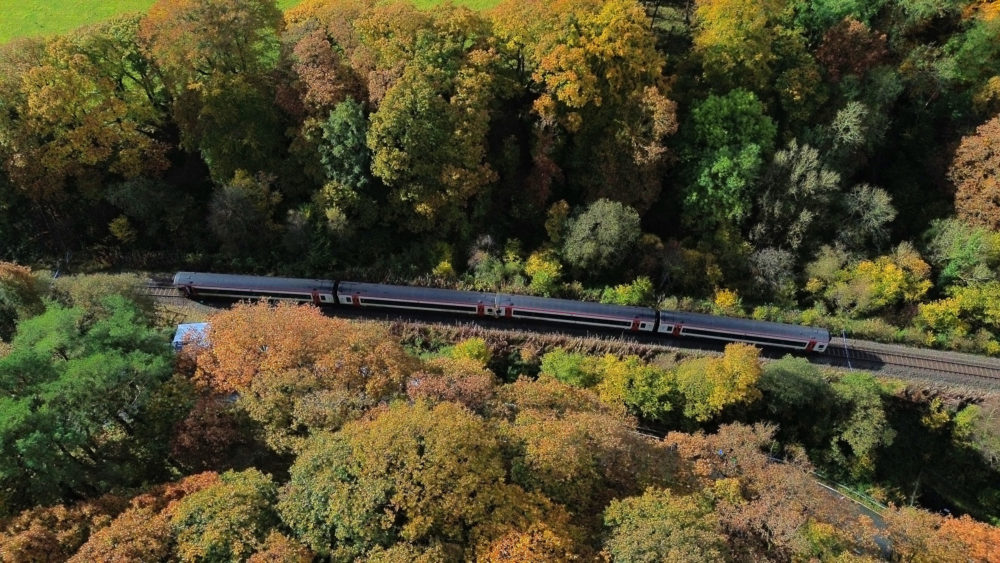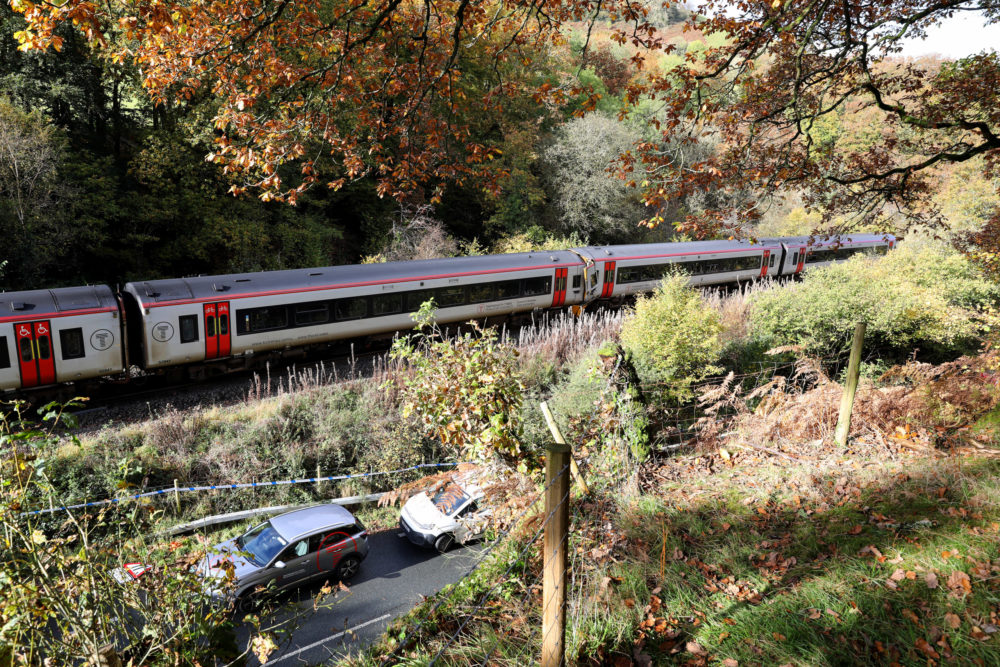What we know so far about the Cambrian Line rail crash

Professor Stuart Cole, CBE. Emeritus Professor of Transport Economics
Last Monday evening’s rail crash near Talerddig in Powys sadly claimed the life of one passenger and caused injuries to several other passengers and a driver.
The incident is being investigated by the independent Rail Accident Investigation Branch (RAIB) whose procedures have always been very thorough. They will identify the causes of the crash where two trains ran head-on into one another. While conjecture on the causes is not appropriate at this point some more complex aspects deserve analysis.
Considerable work now must also be done to restore services and public confidence in the railway.
Location of the accident
The passing loop through which the Aberystwyth bound service passed is on the site of Talerddig railway station (now closed) which has always (since 1863) been a crossing point on the line. It sits at the head of an incline where a westbound train gathers speed passing through the Talerddig cutting.
Although the site is remote – at 13 miles from Machynlleth, Aberystwyth (31), Newtown (24) and Shrewsbury (54) emergency services arrived at the crash site as quickly as those distances allowed. Of considerable help to the rescue teams was the A 470 trunk road located only yards from the railway line where the collision occurred.
Leaf fall
The RAIB team in its initial inspection of the track have suggested that one key area of investigation will be the extent of relatively low wheel / track adhesion suggesting that the train slid along the track when braking. One indication of this would be a flat section on the wheels. Network Rail operated one of their powerful water-jet leaf-clearing trains along the Cambrian line on the previous Sunday night.

The location on the Cambrian railway line is wooded on both sides of the track and at this time of year would have experienced considerable leaf fall. For many years ‘leaves on the line’ was the subject of derisive humour despite workmen with brushes being replaced some years ago by leaf clearing bright-yellow trains whose powerful water-jet mechanisms blast away leaf residue even if thickly coating the track. In addition, adhesion modifier (comprising sand, aluminium and adhesive) is applied after the leaves have been washed off to improve adhesion
Ironically on Friday, BBC’s Breakfast programme showed what we all surely thought was a beautiful scene of brown leaves falling in the Conwy valley. Not an infrequent sight recently together with high winds and heavy rainfall which gives increased leaf fall.
Leaf fall affects wheel-track adhesion when several layers are compacted onto the track creating a thin, slippery layer on the rail surface which can prevent wheel-rail contact and a possible chemical reaction producing friction-reducing iron oxides
This can affect braking distances and prevent on-track equipment detecting trains.
There have been several train slip incidents in recent years. Similar conditions to those at Talerddig caused the train collision at a tunnel entrance outside Salisbury in October 2021. One train slipped on crushed leaves and slid past a red signal colliding with the side of another train.
However, there are few circumstances where it is possible for there to be contact between two trains or a train and a road vehicle because of low wheel-track adhesion. The most likely are at rail junctions or at level crossings juxtaposed with particularly high leaf fall.
Single line railways
The Cambrian Line is a single line railway with passing loops to allow Aberystwyth bound trains and those enroute for Shrewsbury to safely pass one another. The loop at Talerddig lies on a slope from the Talerddig summit on a piece of track that has been a challenge to train operators since it was built.
In Wales much of our railway network has been underfunded with a resulting high percentage of single-track rail operation.

Any single line railway where trains travel in both direction on the same piece of track will not be as safe a one with double track where trains are operating on separate lines. Transport for Wales had issued speed restrictions on all single line operations including the Cambrian, Pembrokeshire and Conwy valley lines and the Heart of Wales Line which was closed on the day of the crash.
Several ‘dynamic’ loops have been installed on the Cambrian line in recent years which enable trains to pass each other on single line routes without stopping. Otherwise, trains wait in the loop for the green signal to proceed.
The old token system on the Cambrian line required a driver to obtain a physical ring or baton before proceeding on to a single-track section. A new system was tested on the Cambrian line and fully introduced in 2011. This is the European Train Control System (ECTS) the signalling component of the European Rail Traffic Management System (ERTMS) and now form the basis for Network Rail’s re-signalling programme (including the south Wales main line).
ERTMS / ERTC
Operated from the Machynlleth ERTMS control centre these systems have key safety features to assist the train driver. The braking system on the train is regulated by the ERTC system and is applied automatically if a signal is passed at danger. The RAIB will examine how the system applied itself and where and to what extent the brakes were applied. This enabled the driver to enter the carriage to warn the passengers of the likely impending collision.
This is being introduced throughout the British network to allow passenger and freight trains to enter the European Union network
The trains involved
The trains operating in both directions were 35-year-old Class 158 units designed for long distance services. They are over thirty-years old but there is no interim suggestion that age was a cause of the accident. Indeed, these trains were all refurbished and underwent a high-level maintenance schedule between 2020 and 2022. They will be replaced by new trains currently being introduced on Wales’ rail network
Provision of bus / train services
Rail replacement services have been introduced though in this part of Wales they will not have the advantages of a parallel rail service because:
- The journey time along rural roads will be considerably longer than the rail trip
- At this time of year there is considerable student demand, with associated luggage, and several coaches will be required to replicate the train service
- On this service many stations were closed to make the main line journey time between Aberystwyth and Shrewsbury more attractive to passengers. Consequently, fewer stations must be coach calling points.
Safe travel
Train travel has been shown to be considerably safer than journeys by car in terms of numbers of accidents and injuries or fatalities. Train companies should now reiterate that to customers in particular those leisure travellers who are new customers
The RAIB inquiry
This will normally produce an interim report within weeks though the final report’s publication will be considerably longer.
RAIB will consider its initial finding which have pointed to leaf fall but will examine the condition of the train, analyse its ‘black box’ operational recorder and the railway signalling systems, inspect the track and speak to passengers and railway staff involved.
Support our Nation today
For the price of a cup of coffee a month you can help us create an independent, not-for-profit, national news service for the people of Wales, by the people of Wales.





If the Sandite MPV left Shrewsbury on the Sunday night most likely have gone switched off as far as Machynlleth without de-greasing the track. Driver changed ends, and subsequently treated the track on it’s return journey. This would not have treated the westbound loop section at Talerddig. On the return journey the MPV would divert through the eastbound track in the loop. Some of the Sandite MPVs now have the ‘Teflon Detector’ camera car attached, which consists of a laser scanner pointed at the running rail. It maps the track condition as it progresses. Was it one of these that had… Read more »
I had to take RAIB to First Tier Tribunal. They refused to answer 2 basic questions, regarding other incidents. RAIB pulled the vexation clause of the FOI Act. I regard RAIB as being economical with the truth.
Please note I’m not the Editor but a retired train driver.